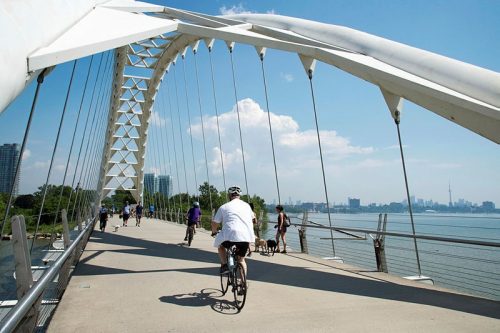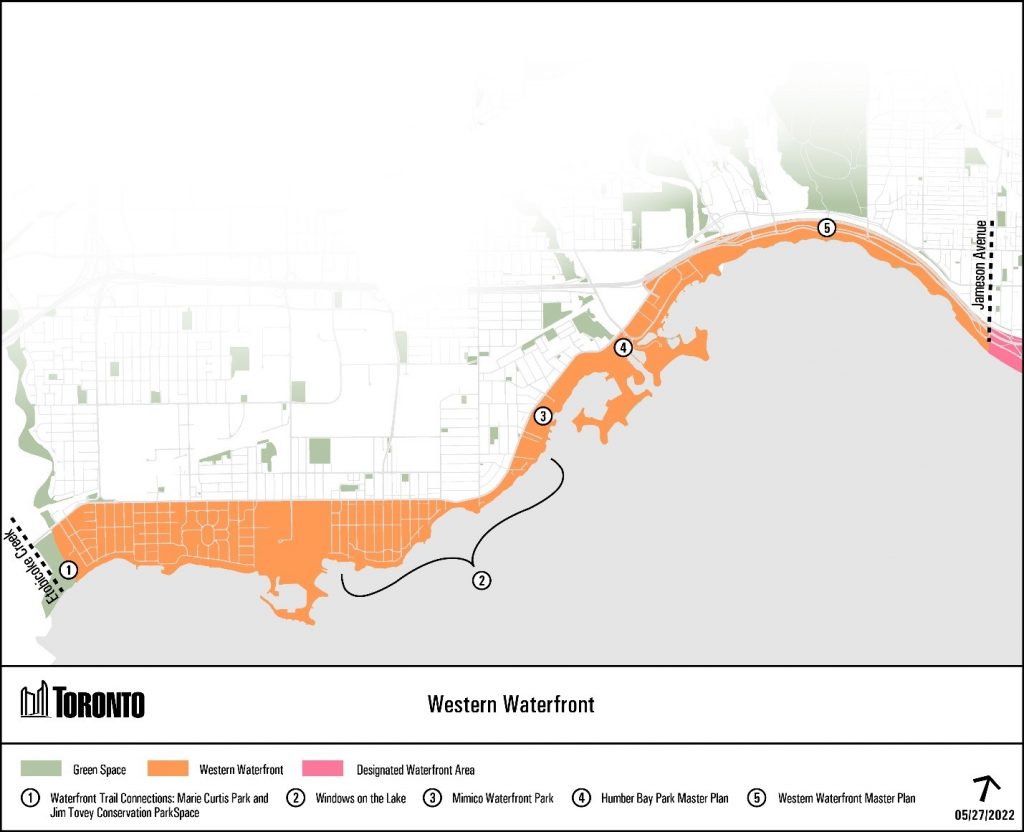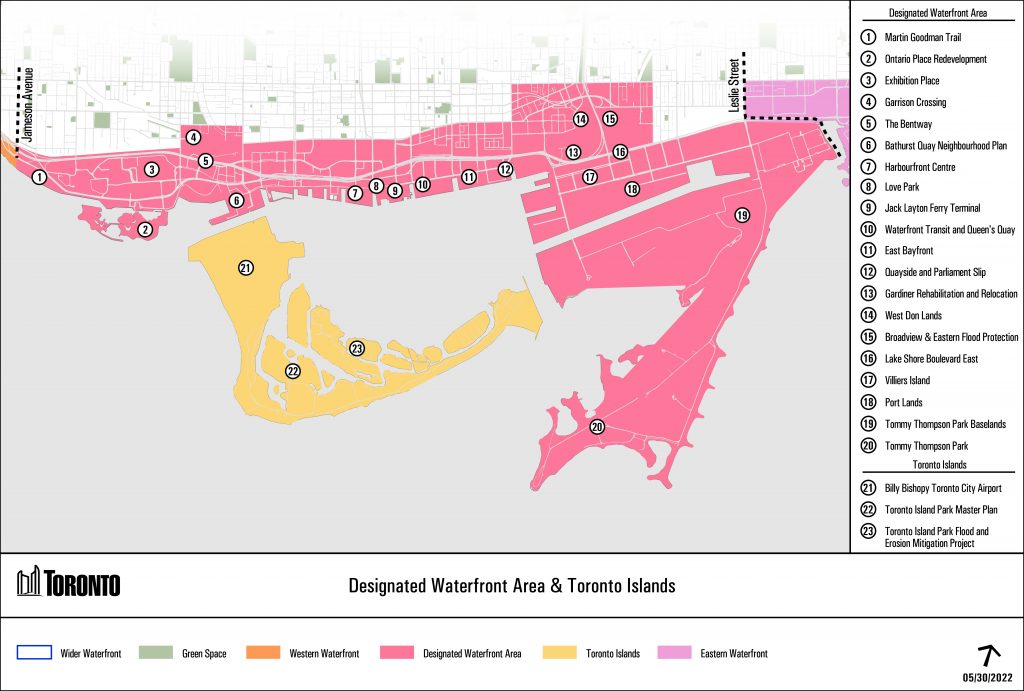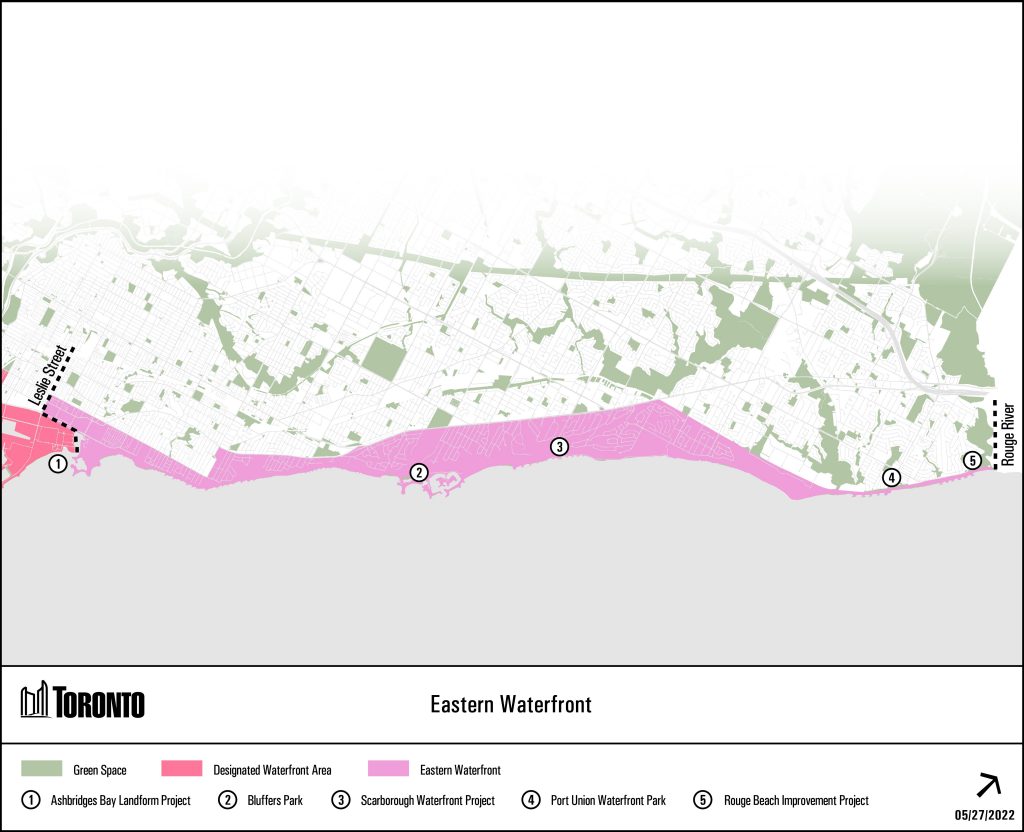
More than 20 years ago, the City, Province and Federal government jointly embarked on a project to make Toronto’s waterfront a place of local, provincial and national pride and public enjoyment. The tri-government approach led to a vision for the future, and the creation of Waterfront Toronto, to implement a forward-thinking vision for Toronto’s central waterfront.
Through $2.75 billion of tri-government investment, the construction of complete communities and public realm improvements physically transformed Toronto’s downtown waterfront to bring significant economic, social and environmental benefits to residents and businesses.
However, the task is far from complete. In response to City Council direction, City staff are reflecting on previous efforts and engaging in a public, stakeholder and Indigenous engagement process to refresh the vision for waterfront revitalization. While the original vision for Toronto’s downtown waterfront and several precinct plans and frameworks remain relevant, significant time has passed and it could be updated to reflect today’s priorities such as:
Toronto’s wider waterfront comprises the 43 kilometer stretch from Etobicoke to Scarborough, including the western, central and eastern waterfront, as well as the Toronto Islands.
The renewed vision for the next phase of waterfront revitalization will inform the continued transformation of Toronto’s central waterfront, as well as complementary, coordinated investments across the full 43 kilometer span of the wider waterfront, from Etobicoke to Scarborough.
A staff report advancing the renewed vision and recommended next steps, along with the Public and Stakeholder Engagement Summary and Igniting Innovation: Call to Action for Innovation-led Economic Development on Toronto’s Waterfront, was adopted at the July 19, 2022 City Council meeting.
The Indigenous Engagement Summary Report and presentation documents the ongoing discussions about the next phase of waterfront revitalization with First Nations, Inuit, Métis and urban Indigenous communities.
A renewed vision aims to address the importance of the waterfront to Indigenous communities and advance City commitments to take meaningful action to advance truth, justice and reconciliation, including through priorities identified in the Reconciliation Action Plan. The next phase of waterfront revitalization will build on engagement with First Nations, Métis and Inuit communities, including Treaty and Territorial partners and urban Indigenous organizations and community members.
A renewed vision will identify specific economic themes that support post-pandemic recovery and deliver on economic, social and environmental outcomes. To date, waterfront revitalization has incorporated innovative approaches to city-building and these approaches will continue to inform precinct planning for future waterfront neighbourhoods, communities and industrial sectors.
A renewed vision provides the opportunity to create a more inclusive waterfront in alignment with City strategies that advance equitable outcomes related to affordable housing, accessible design, racial equity, pedestrian and cycling connections, transit infrastructure and community services. The next phase of waterfront revitalization could be used to ensure that City services, spaces and programs along the waterfront continue to be inclusive and accessible to all Torontonians.
The next phase of waterfront revitalization will embed climate resilience and TransformTO greenhouse gas reduction targets into infrastructure projects (i.e. transit, flood protection) and set a precedent for climate positive design. Ongoing precinct development will advance climate positive design and aquatic habitat restoration while advancing public realm improvements and demonstrating how climate resilient initiatives can flourish along Toronto’s waterfront.
A longstanding history of public consultation has informed waterfront revitalization policy and project priorities. The City, with support from its waterfront and government partners, is undertaking a virtual public consultation and stakeholder engagement process to gather public input on a renewed vision.
There were three virtual public meetings held in February and March:
These virtual public meetings presented an update on the waterfront revitalization and included opportunities to gather public feedback. All three meetings had the same content and format, with a presentation followed by a workshop.
Stakeholder consultations are ongoing, with thematic focuses on parks and public realm, health and wellbeing, housing and complete communities, mobility and connectivity, environment and climate change, and creative industries and economic development.
The public meeting presentation is available below for reference.
The Next Phase of Waterfront Revitalization – Public Meeting Presentation
Do you love Toronto’s waterfront and have ideas for its future?
Tell us using your camera – take a photo of something you love about the waterfront, or ideas you have for its future. Post the photo and your ideas on Instagram, Facebook or Twitter and hashtag it with #mywaterfrontTO.

The waterfront has over 12,000 years of history as an important place for Indigenous communities. This is evident in Toronto’s name, derived from the word “Tkaranto,” meaning “where there are trees in the water.” The water and waterfront’s historical, cultural and ongoing significance to Indigenous communities compels the City to take special care and engage in collaborative approaches to the next phase of waterfront revitalization.
Engagement on the next phase of revitalization includes First Nations, Inuit, Métis Peoples and urban Indigenous organizations and communities. This includes Treaty and Territorial partners such as the Mississaugas of the Credit First Nation, Huron-Wendat Nation and Six Nations of the Grand River.
The Indigenous Engagement Summary Report and presentation documents the initial discussions about the next phase of waterfront revitalization with First Nations, Inuit, Métis and urban Indigenous communities, that took place in 2022-2023. City staff and Indigenous engagement consultant, Andrea L.K. Johnston, presented to the Aboriginal Affairs Advisory Committee on June 13, 2022.
These discussions informed the renewed vision and identified opportunities for advancing the Reconciliation Action Plan through waterfront revitalization and restoration projects.
Input heard from Indigenous community engagement continues to inform the planning, design and implementation of various interconnected waterfront projects. Projects include those in the Port Lands, such as the Port Lands Indigenous Place Naming, the Western Beaches Public Realm Plan, and other projects in partnership with Waterfront Toronto (Quayside), TRCA (Scarborough Bluffs West Revitalization Study) and CreateTO (McCleary Precinct Plan).
More information on engagement opportunities can be found through the:
Through the 2022 budget cycle, Council approved the creation of staff positions within the Indigenous Affairs Office which are supporting this work, including one staff specifically focused on Indigenous affairs on the waterfront.
The renewed vision for the next phase of waterfront revitalization expands beyond the Designated Waterfront Area (Central Waterfront), to the Western and Eastern Waterfronts, from Etobicoke to Scarborough. Learn more about the ongoing and future revitalization initiatives below, implemented in partnership between the City of Toronto, Waterfront Toronto, Toronto and Region Conservation Authority and other partners.


